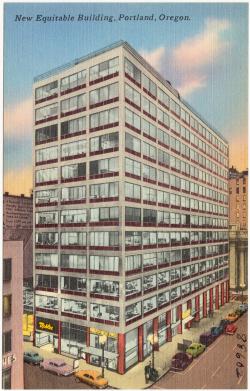
The use of heat pumps for the heating and cooling of the Commonwealth Building, initiated in 1948, was a pioneering achievement in the western hemisphere. The theoretical conception of the heat pump was described in a neglected book, published in 1824 and written by a young French army officer, Sadi Carnot. Its practical application on a large scale is attributable to designers J. Donald Kroeker and Ray C. Chewning, building engineer Charles E. Graham, and architect Pietro Belluschi. Following a World War II moratorium on construction of commercial buildings, this unique all aluminum-clad building received the first permit and became a standard style for several decades. Though located in a moderate climate, the building requires air-conditioning because it has no opening windows. Kroeker designed the heating, ventilating, and air-conditioning system with special features that included heat recovery from ventilation exhaust air and use of waste cooling water to heat incoming ventilation air. The 14-story building has separate heating and cooling circuits controlled by thermostat. The basic heat pumps are four condensing units that pump water from two warm wells. Two units use Freon 11 and two use Freon 113.


